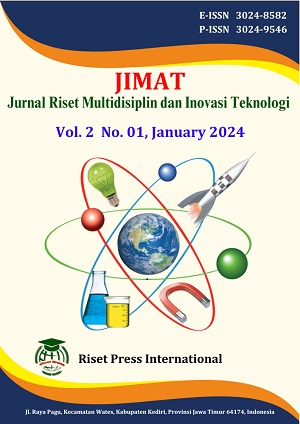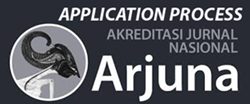Test of Escherichia Coli and Total Microbes on Burger Meat Sold in Kedinding and Pogot Villages, Surabaya, East Java
DOI:
https://doi.org/10.59653/jimat.v2i01.367Keywords:
Burger, Escherichia coli, Total Plate Count (TPC)Abstract
A burger is a type of fast food that consists of a bun in the middle that contains a patty (ground beef), vegetables, and some sauce. There are several parameters in determining food quality and safety, one of which is analyzing the content of microbiology such as bacteria, viruses, and protozoa in food. Biological hazards, especially in food, need special attention because they are often the causative agents of food poisoning cases. This study aims to determine Eschericia coli contamination and Total Plate Number (TPC) in burger meat samples sold in Kedinding and Pogot villages, Surabaya, East Java. This research is observational with a cross sectional approach. The inspection method used to determine Escherichia coli contamination and the Total Plate Count (TPC) is the Most Likely Number method to determine E. coli and the Total Plate Count (TPC). The results of this study showed that there was no E. coli in all burger meat samples and there were 6 burger meat samples contaminated with bacteria, namely in Samples A, B, C, G, H and I, which exceeded the contamination limit according to to SNI 8503 (2018).
Downloads
References
Ademi, B. F., & Rinanda, T. (2011). Deteksi Cemaran Escherichia coli pada Daging Burger Penjual Kaki Lima di Desa Kopelma Darussalam dan Restoran Cepat Saji di Banda Aceh. Jurnal Kedokteran Syiah Kuala, 11(3), 134–142.
Bintsis, T. (2018). Microbial Pollution and Food Safety. AIMS Microbiology, 4(3), 377–396.
BPOM. (2018). Pengujian Mikrobiologi Pangan. Info POM, 9(2), 1–9.
Fadjar Kurnia, H. (2016). Evaluasi Metode Pengujian Angka Lempeng Total Menggunakan Metode Petrifilm Aerobic Count Plate Terhadap Metode Uji Sni 01.2332.2006 Pada Produk Perikanan Di Lppmhp Surabaya. Heuristic, .Vol 13(2), 90–105.
Fukuda A, Usui M, Masui C, T. Y. (2019). Quantitative Analysis of Houseflies-mediated Food Contamination with Bacteria. Food Saf (Tokyo)., 7(1), 89–105.
Jamilatun, M. (2022). Analisis Cemaran Mikroba Angka Lempeng Total ( ALT ) pada Kue Jajanan Pasar. Jurnal Ilmiah Multidisiplin, 1(5), 1243–1248.
Nurmawati, S., Prodjosoewojo, S., Chairunnisa, NH., Djauhari, H., dan Alisjahbana, B. (2019). Faktor Risiko Penyebab Foodborne Disease pada Siswa SD. Jurnal Sains Dan Kesehatan, 4(4), 180–184.
Puspitasari, N. . dan S. H. (2015). Pengaruh bentuk dan subtitusi ampas tahu terhadap hasil jadi burger ayam. E-Journal Boga, 4(1), 183–191.
Riyanto, A. (2012). Efektivitas Tisu Basah Antiseptik sebagai Alat Alternatif Cuci Tangan Biasa dalam Menurunkan Jumlah Bakteri Telapak Tangan. STIKES Jenderal Ahmad Yani Cimahi.
Sugiyono. (2009). Metode penelitian pendidikan pendekatan kuantitatif, kualitatif, dan R&D. Alfabeta Bandung.
Sultia, B. N., & Dr. Endang Mulyatiningsih, M. P. (2021). Subsitusi Tepung Rumput Laut (Eucheuma Cottoni) Pada Pembuatan Burger Dengan Patty Ikan Nila Bumbu Taliwang Sebagai One Dish Meal. Jurnal Penelitian, 15(1), 1–7. https://journal.uny.ac.id/index.php/ptbb/article/view/35992/14702
Widyaningsih, W., Supriharyono, S., & Widyorini, N. (2016). Analisis Total Bakteri Coliform Di Perairan Muara Kali Wiso Jepara. Management of Aquatic Resources Journal (MAQUARES), 5(3), 157–164. https://doi.org/10.14710/marj.v5i3.14403
Winartha, I. M. (2006). Metode Penelitian Sosial Ekonomi. Andi Offset Yogyakarat.
Downloads
Published
How to Cite
Issue
Section
License
Copyright (c) 2023 Jamila Tuljannah, Fadjar Kurnia Hartati

This work is licensed under a Creative Commons Attribution-ShareAlike 4.0 International License.
Authors who publish with this journal agree to the following terms:
- Authors retain copyright and grant the journal right of first publication with the work simultaneously licensed under a Creative Commons Attribution-ShareAlike that allows others to share the work with an acknowledgement of the work's authorship and initial publication in this journal.
- Authors are able to enter into separate, additional contractual arrangements for the non-exclusive distribution of the journal's published version of the work (e.g., post it to an institutional repository or publish it in a book), with an acknowledgement of its initial publication in this journal.
- Authors are permitted and encouraged to post their work online (e.g., in institutional repositories or on their website) prior to and during the submission process, as it can lead to productive exchanges, as well as earlier and greater citation of published work (See The Effect of Open Access).























